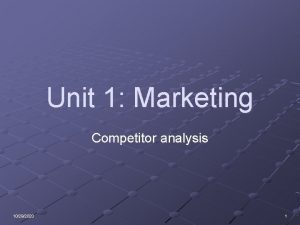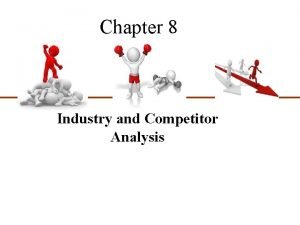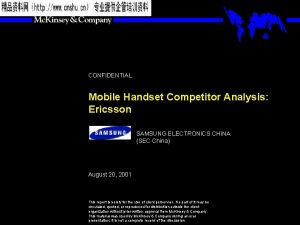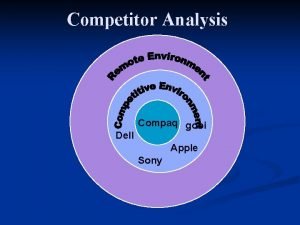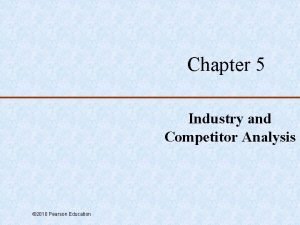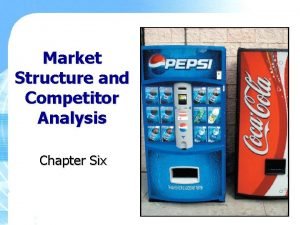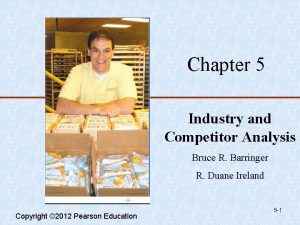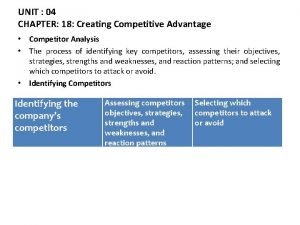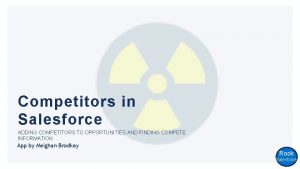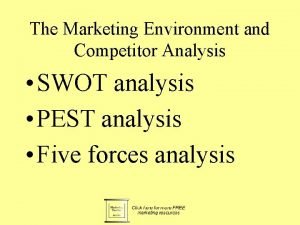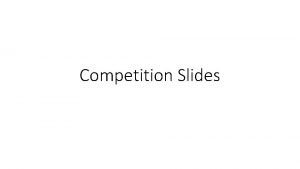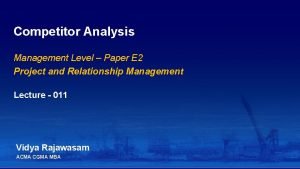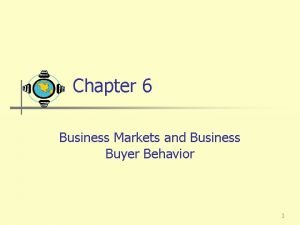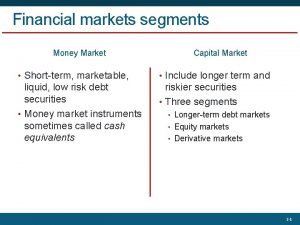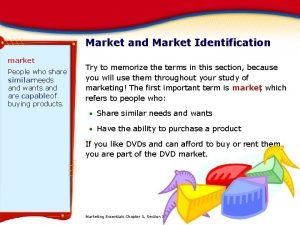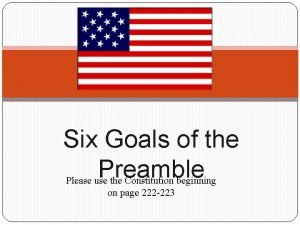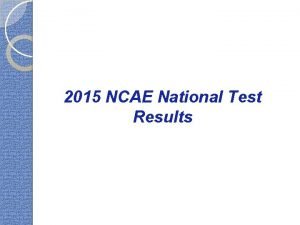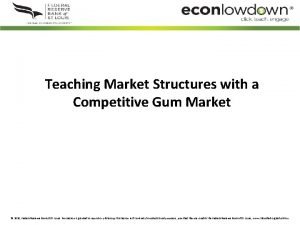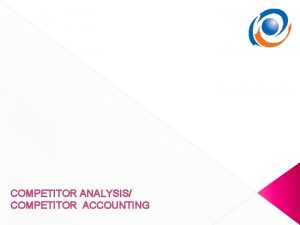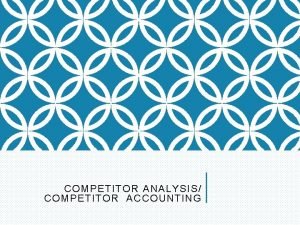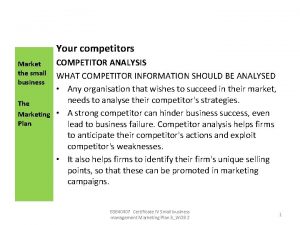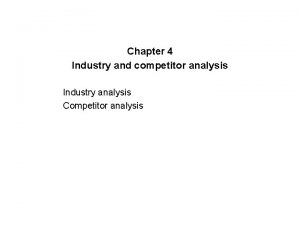Market Structure and Competitor Analysis Chapter Six Key










































- Slides: 42

Market Structure and Competitor Analysis Chapter Six

Key Learning Points Performing a market structure analysis, which identifies a firm’s major competitors Performing a competitor analysis Alternative sources of information for analyzing competitors Using game theory in the development of competitive strategy Copyright © 2011 Pearson Education, Inc. , Publishing as Prentice Hall 6 -2

Overview Market structure and competitive analysis are critical to the development of marketing plans. Copyright © 2011 Pearson Education, Inc. , Publishing as Prentice Hall 6 -3

“The purpose of a market structure analysis is to enable the marketing manager to understand who the competition is. Misidentification of the competitive set can have a serious impact on the success of a marketing plan, especially in the long run. ” - Russell S. Winer Copyright © 2011 Pearson Education, Inc. , Publishing as Prentice Hall 6 -4

Market Structure Analysis Identifying competition is critical. Failing to identify a competitive threat can have disastrous consequences. Competitors must be identified in order to properly compute market share. Copyright © 2011 Pearson Education, Inc. , Publishing as Prentice Hall 6 -5

Market Structure Analysis Methods of identifying competitors Supply-based approaches Demand-based approaches Copyright © 2011 Pearson Education, Inc. , Publishing as Prentice Hall 6 -6

Figure 6. 1 Product-Industry Hierarchy Copyright © 2011 Pearson Education, Inc. , Publishing as Prentice Hall 6 -7

Figure 6. 2 Levels of Competition: Drip Coffee Makers Copyright © 2011 Pearson Education, Inc. , Publishing as Prentice Hall 6 -8

Discussion Question Consider Miller Genuine Draft for a moment. What brands, products, or services would you classify as product form, product class, generic, and budget level competitors? Copyright © 2011 Pearson Education, Inc. , Publishing as Prentice Hall 6 -9

Market Structure Analysis Four-level model of competition implies different tasks for each competitive level. Product form competition Product category competition Generic competition Budget competition

Figure 6. 3 Altoids Advertisement Altoids created a desire for stronger or “nasal flaring” products, resulting in $117 million in sales during 2004. How would you define Altoids competition? Copyright © 2011 Pearson Education, Inc. , Publishing as Prentice Hall 6 -11

Market Structure Analysis Demand based methods of defining competition Cross-elasticity of demand: Positive cross-elasticity indicates competitors. Major problems exist with crosselasticity interpretation. Copyright © 2011 Pearson Education, Inc. , Publishing as Prentice Hall 6 -12

Market Structure Analysis Demand based methods of defining competition Substitution in use Consumers estimate the degree of competitiveness through judged similarity of products in usage contexts. Copyright © 2011 Pearson Education, Inc. , Publishing as Prentice Hall 6 -13

Market Structure Analysis Supply-based methods of defining competition Observation (managerial judgment) External data sources Government documents provide a great deal of data. NAFTA classifications are often used. Copyright © 2011 Pearson Education, Inc. , Publishing as Prentice Hall 6 -14

Table 6. 1 Concentration by Largest Firms for the United States: 2002 Copyright © 2011 Pearson Education, Inc. , Publishing as Prentice Hall 6 -15

Market Structure Analysis Supply-based methods of defining competition Trade associations, consultants, and others may supply category or industry definitions. Generic and budget level competitors are the most difficult to determine. Copyright © 2011 Pearson Education, Inc. , Publishing as Prentice Hall 6 -16

Competitor Analysis Competitor analysis is increasing in importance. Training efforts Visit the society for competitive analysis Competitive intelligence activities have an unsavory reputation. The competitor analysis framework consists of four key phases of analysis. Copyright © 2011 Pearson Education, Inc. , Publishing as Prentice Hall 6 -17

Figure 6. 4 Competitor Analysis Framework Copyright © 2011 Pearson Education, Inc. , Publishing as Prentice Hall 6 -18

Competitor Analysis Assess competitive objectives: Competitors’ objectives offer insight into future strategies. Ownership status should be considered when assessing objectives. Private-owned firms Government-owned firms Copyright © 2011 Pearson Education, Inc. , Publishing as Prentice Hall 6 -19

Competitor Analysis Assess competitive strategy: Customer and competitor targets Product features Core strategies Supporting marketing mix Copyright © 2011 Pearson Education, Inc. , Publishing as Prentice Hall 6 -20

Table 6. 2 Produce Feature Matrix: Small Sports Sedans Copyright © 2011 Pearson Education, Inc. , Publishing as Prentice Hall 6 -21

Figure 6. 5 Xerox Advertisement The value proposition of this ad focuses on the reduced cost of color printing. SRDS can be used to discern the target market. Copyright © 2011 Pearson Education, Inc. , Publishing as Prentice Hall 6 -22

Competitor Analysis Assess competitive strategy. Supporting marketing mix: Price Communications Distribution Product or service capabilities Assess competitor strengths and weaknesses. Copyright © 2011 Pearson Education, Inc. , Publishing as Prentice Hall 6 -23

Table 6. 3 Competitor Capabilities Matrix Copyright © 2011 Pearson Education, Inc. , Publishing as Prentice Hall 6 -24

Table 6. 3 Competitor Capabilities Matrix Copyright © 2011 Pearson Education, Inc. , Publishing as Prentice Hall 6 -25

Competitor Analysis Firms must also assess their own strengths and weaknesses accurately. Information should be summarized using one of two techniques. Differential competitor advantage analysis SWOT analysis Copyright © 2011 Pearson Education, Inc. , Publishing as Prentice Hall 6 -26

Table 6. 5 Differential Competitor Advantage Analysis Copyright © 2011 Pearson Education, Inc. , Publishing as Prentice Hall 6 -27

Figure 6. 6 SWOT Analysis Copyright © 2011 Pearson Education, Inc. , Publishing as Prentice Hall 6 -28

Competitor Analysis Expected future strategies End result of competitive analysis is a forecast of competitors’ likely actions. Sources of forecasts vary Published Trend forecasting Simulation Scenario planning Copyright © 2011 Pearson Education, Inc. , Publishing as Prentice Hall 6 -29

Table 6. 6 Three Scenarios Copyright © 2011 Pearson Education, Inc. , Publishing as Prentice Hall 6 -30

Where Do We Get the Information? Secondary Information Sources Internal sources Annual reports Trademark and patent filings Other govt. sources General business & trade publications Copyright © 2011 Pearson Education, Inc. , Publishing as Prentice Hall Consultants Trade associations Help wanted advertisements Electronic data services 6 -31

Where Do We Get the Information? Electronic data services: Hoover’s online Din & Bradstreet’s online access News. Directory’s 24 -hour newsstand American demographics Competitive intelligence guide DIALOG Specialized web-based services

Where Do We Get the Information? Primary Information Sources Sales force and customers Employees Suppliers Trade shows Copyright © 2011 Pearson Education, Inc. , Publishing as Prentice Hall Reverse engineering Plant tours Blogs & Internet newsgroups 6 -33

Illustration Trade shows are important for displaying new products, but are also excellent sources of information about competitors. Copyright © 2011 Pearson Education, Inc. , Publishing as Prentice Hall 6 -34

Activity Partner with another student who represents your competitor. You each must decide whether to raise your price to $300 or keep it at $200. Do not discuss your strategy with your partner. Write down your price on a piece of paper, fold it, and hand it to your partner to keep until later. Copyright © 2011 Pearson Education, Inc. , Publishing as Prentice Hall 6 -35

Competitive Strategy: Some Game Theory Notions Game theory offers a more formal and analytical process for anticipating competitors future strategies into decision-making. Assumptions Non-cooperative game theory Requirements Copyright © 2011 Pearson Education, Inc. , Publishing as Prentice Hall 6 -36

Figure 6. 7 A Pricing Game Copyright © 2011 Pearson Education, Inc. , Publishing as Prentice Hall 6 -37

“A Nash equilibrium is a list of strategies, one for each player, with the property that no manager wants to unilaterally change his or her strategy. In other words, for each manager, its strategy in the equilibrium is the best response to the others’ strategies in the equilibrium. ” - Russell S. Winer Copyright © 2011 Pearson Education, Inc. , Publishing as Prentice Hall 6 -38

Competitive Strategy: Some Game Theory Notions Prisoner’s dilemma game Game theory can be extended to incorporate the leader–follower concept. Copyright © 2011 Pearson Education, Inc. , Publishing as Prentice Hall 6 -39

Figure 6. 8 A Leader-Follower Game Copyright © 2011 Pearson Education, Inc. , Publishing as Prentice Hall 6 -40

Competitive Strategy: Some Game Theory Notions Game theory imposes disciplined thinking on managers. Game theory can be used with new product entrants. Game theory can be applied to manufacturer – retailer relations. Copyright © 2011 Pearson Education, Inc. , Publishing as Prentice Hall 6 -41

Key Learning Points Market structure analysis assesses competition. A broad view of competition is desirable. Analyze competitive strengths and weaknesses, and predict strategies. Primary and secondary sources provide competitive information. Applying game theory can help reveal competitors’ future actions and impact. Copyright © 2011 Pearson Education, Inc. , Publishing as Prentice Hall 6 -42
 Competitors analysis grid
Competitors analysis grid Lehmann and winer competitor analysis
Lehmann and winer competitor analysis Industry analysis in feasibility study
Industry analysis in feasibility study Myk pono competitor analysis
Myk pono competitor analysis Competitor analysis theory
Competitor analysis theory Nokia competitor analysis
Nokia competitor analysis Samsung competitor analysis
Samsung competitor analysis Analysis apple streetjournal fy 2b sony
Analysis apple streetjournal fy 2b sony Competitor analysis grid
Competitor analysis grid Competitor analysis theory
Competitor analysis theory Competitive analysis grid
Competitive analysis grid Difference between segmentation targeting and positioning
Difference between segmentation targeting and positioning Hypothetical market structure
Hypothetical market structure Competitor centered company
Competitor centered company The attacking firm goes head-to-head with its competitor.
The attacking firm goes head-to-head with its competitor. Starbucks wheel
Starbucks wheel Marsello competitor
Marsello competitor Meighan brodkey
Meighan brodkey Competitor analisys
Competitor analisys Sports competitor worksheet
Sports competitor worksheet Competition comparison table
Competition comparison table Competitor intelligence should be gathered mcq
Competitor intelligence should be gathered mcq Classify each polygon
Classify each polygon Business model canvas key partner
Business model canvas key partner Business model canvas tripadvisor
Business model canvas tripadvisor Chapter 22 plant structure and function answer key
Chapter 22 plant structure and function answer key Capital structure in a perfect market
Capital structure in a perfect market Primary target market and secondary target market
Primary target market and secondary target market Participants in the business buying process
Participants in the business buying process Bond equivalent yield formula
Bond equivalent yield formula Concept of market and market identification
Concept of market and market identification What is ipo
What is ipo Money market and its functions
Money market and its functions 7 ionic and metallic bonding
7 ionic and metallic bonding Chapter 7 ionic and metallic bonding answer key
Chapter 7 ionic and metallic bonding answer key Chapter 4 section 2 the structure of atoms
Chapter 4 section 2 the structure of atoms 6 kingdoms dichotomous key
6 kingdoms dichotomous key Six goals in the preamble
Six goals in the preamble What are national core standards?
What are national core standards? Ncae test results
Ncae test results Teaching market structures with a competitive gum market
Teaching market structures with a competitive gum market Give the four market forms of meat
Give the four market forms of meat Space market vs asset market
Space market vs asset market

